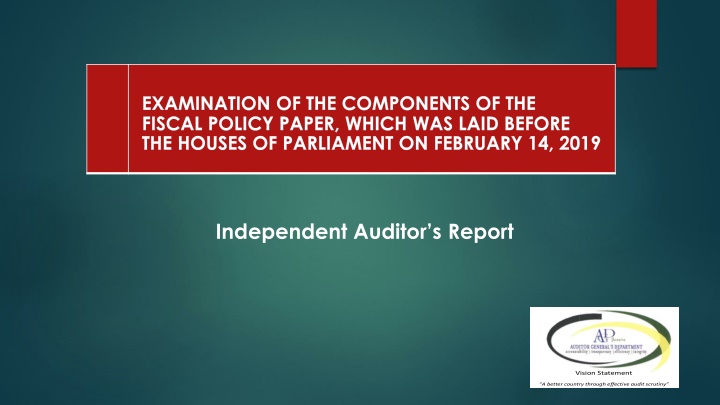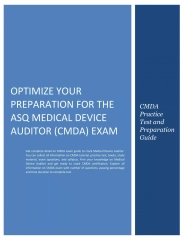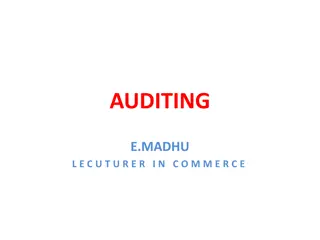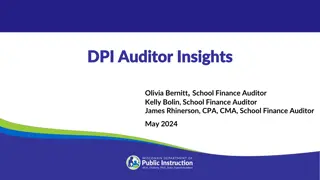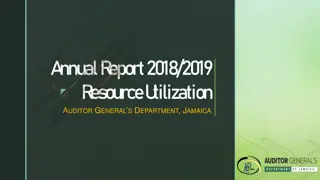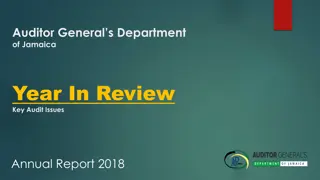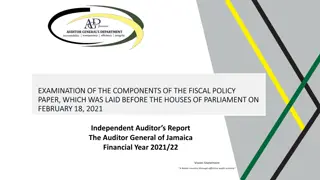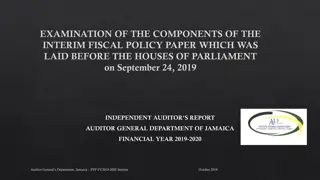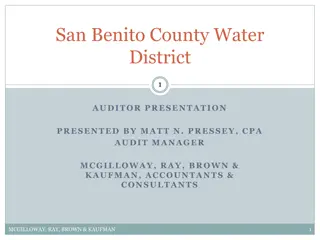Independent Auditor’s Report
This paper presents the independent auditor's report and the Auditor General's examination of the Fiscal Policy Paper for FY2019/20. It discusses the adherence to principles of prudent fiscal management, macroeconomic assumptions, fiscal responsibility, and identification of fiscal risks.
Download Presentation

Please find below an Image/Link to download the presentation.
The content on the website is provided AS IS for your information and personal use only. It may not be sold, licensed, or shared on other websites without obtaining consent from the author.If you encounter any issues during the download, it is possible that the publisher has removed the file from their server.
You are allowed to download the files provided on this website for personal or commercial use, subject to the condition that they are used lawfully. All files are the property of their respective owners.
The content on the website is provided AS IS for your information and personal use only. It may not be sold, licensed, or shared on other websites without obtaining consent from the author.
E N D
Presentation Transcript
EXAMINATION OF THE COMPONENTS OF THE FISCAL POLICY PAPER, WHICH WAS LAID BEFORE THE HOUSES OF PARLIAMENT ON FEBRUARY 14, 2019 Independent Auditor s Report Vision Statement A better country through effective audit scrutiny
Auditor Generals Comments My Examination of the Fiscal Policy Paper (FPP) for FY2019/20 revealed that it met the requirements of the Third Schedule of the Financial Administration and Audit Act. The FPP included the minimum content under the Fiscal Responsibility Statement, Macroeconomic Framework and Fiscal Management Strategy.
Auditor Generals Responsibilities Section 48B (6) of the FAA Act requires the Auditor General to examine the components of the Fiscal Policy Paper and provide a report to the Houses of Parliament indicating whether: - (a) The conventions and assumptions underlying the preparation of the Fiscal Policy Paper comply with the principles of prudent fiscal management specified in Section 48D;
The Fiscal Responsibility Statement FY2019/20 Government is committed to the tenets of prudent fiscal management through strict adherence to targets; continuous monitoring of fiscal events and willingness to make timely and sound fiscal decisions; AG.s Evaluation of the Macroeconomic Assumptions Principles of prudent Fiscal Management The Budget must be based on a realistic macroeconomic framework; Reasonably assured that the macroeconomic assumptions underlying the preparation of the FPP comply with principles of prudent fiscal management; Estimates of expenditure must be based on reasonable revenue projections; Following implementation of the enhanced Fiscal Rules in FY2014/15, the accuracy of GDP and inflation forecasts improved significantly; Public deficit be maintained at a level consistent with other macroeconomic objectives and eternal credit worthiness; The size and direction of the fiscal balance and public debt relied on the macroeconomic assumptions; The robustness of nominal GDP is critical as it is the base the wage and Debt ratios and any slippage in forecast can result in failure to meet the fiscal targets. Any revenue or expenditure measure posing a risk to the achievement of the targets would not be adopted without the identification and implementation of requisite offsetting measures. Risks to achievement of the fiscal targets must be identified and evaluated, to enable cost-effective and appropriate risk mitigating measures, consistent with the broader policy objectives.
Risks related public entities that may require Central Government support to cover operating cost or pay debt assumption in FY2019/20 were identified but not quantified for major public bodies. The Fiscal Risk Statement (FRS) identified major risks that could cause the Government s fiscal performance to deviate from forecast or pose a threat to sustainability over the long-term. Conventions of prudent fiscal management require a realistic assessment of risk The projected fall in the public debt to GDP ratio for FY2019/20 and over the medium term is largely underpinned by the forecasted growth in nominal GDP. Hence, if GDP falls short of target and mitigating strategies are not in place, the legislated public debt to GDP target could be under threat. If outstanding Wages & Salaries settlements exceed target in FY2019/20 and, there are no mitigating strategies; or if nominal GDP growth falls short of projection, the legislated wage to GDP target could be missed.
Section 48B (6) of the FAA Act requires the Auditor General to examine the components of the Fiscal Policy Paper and provide a report to the Houses of Parliament indicating whether: - (b) The reasons given, pursuant to subsection (5) (d) (ii) are reasonable having regard to the circumstances; Disclaimer The Fiscal Management Strategy provided an assessment of the fiscal outturn to December 2018 and the estimated outturn to end-March 2019, relative to the First and Second Supplementary Estimates, respectively. As I reminded in my previous reviews, the FAA Act requires a comparison of actual fiscal outturn to the Original Budget, based on macroeconomic assumptions. In light of the absence of the required comparison, in breach of the FAA Act, I am unable to comment on the reasonableness of the explanation for the deviations from Budget.
Auditor Generals Recommendation Given importance of achieving the legislated debt target of 60 per cent of GDP by FY2025/26, future Fiscal Policy Papers should disclose the source of net public sector debt projections in accordance with the principles of transparency. I also recommended adherence to the provisions of the FAA Act, by providing the appropriate comparison of actual outturn with the Original Budget.
Fiscal Targets key:On track Keep in view Target at risk To attain a fiscal balance as a percentage of Gross Domestic Product, as at the end of the financial year ending March 31, 2018 and thereafter, that allows the requirement specified in paragraph (b) to be achieved, and to be maintained or improved thereafter, and the fiscal balance to be attained shall be computed in accordance with the Fifth Schedule. To reduce the public debt to sixty per cent or less of Gross Domestic Product by the end of the financial year ending March 31, 2026, and maintain or improve the ratio thereafter. To ensure that neither the Appropriation Act nor any Supplementary Estimates of Revenue and Expenditure for any financial year will cause any negative deviations from the fiscal balance to be attained pursuant to paragraph (a). To ensure that no deviation is recorded in the notional account until the fiscal accounts for the financial year in question have been finalised. To reduce the ratio of wages paid by the Government as a proportion of the Gross Domestic Product to 9 per cent or less by the end of the financial year ending March 31, 2019 and maintain or improve the ratio thereafter [FAA (Amendment) Act 2016].
Fiscal and Primary Balance: Attainment of the Fiscal and Primary balance targets for FY2019/20 and the medium-term is dependent on prudent fiscal management, underpinned by credible macroeconomic assumptions and the identification and management of fiscal risks. 8.0% 7.0% 6.0% 5.0% 4.0% % OF GDP 3.0% 2.0% 1.0% 0.0% -1.0% FY2018/19 Est. 0.3% 7.0% FY2019/20 Proj. 0.7% 7.0% FY2020/21 Proj. 1.0% 7.0% FY2021/22 Proj. 1.7% 7.0% FY2022/23 Proj. 2.3% 7.0% FY2016/17 FY2017/18 Fiscal Balance Primary Balance 0.2% 7.6% 0.5% 7.4%
Tax Revenue: If the downside risk to nominal GDP materialises such that, growth is two percentage points lower, then the tax revenue ratio could fall short of projection, given the one-to-one relationship between tax revenue and GDP. 800000.0 26.8 26.6 700000.0 26.4 600000.0 26.2 500000.0 26 J$MN 400000.0 25.8 300000.0 25.6 200000.0 25.4 100000.0 25.2 0.0 25 FY2016/17 458323.4 445488.9 25.6 FY2017/18 496894.6 488629.6 25.7 FY2018/19 Est. 537465.5 518435.3 26.4 FY2019/20 Proj. FY2020/21 Proj. FY2021/22 Proj. FY2022/23 Proj. Actual Budget % of GDP 575710.5 26.7 612185.9 26.4 651910.3 26.3 693337.7 26.2
Wages & Salaries:The risk to the achievement of the legislated target could be greater if Wages & Salaries settlement in FY2019/20 exceeds target or if nominal GDP growth falls short of target and Government fails to implement mitigating strategies. 300000.0 9.35 9.3 250000.0 9.25 9.2 200000.0 9.15 J$MN 150000.0 9.1 9.05 100000.0 9 8.95 50000.0 8.9 0.0 8.85 FY2016/17 166484.7 170193.5 9.3 FY2017/18 178366.3 185258.1 9.2 FY2018/19 Est. 183403.9 185274.7 9.0 FY2019/20 Proj, FY2020/21 Proj. FY2021/22 Proj. FY2022/23 Proj. Actual Budget % of GDP 193958.3 9.0 208772 9.0 223380.1 9.0 239282 9.0
Public Debt: The projected fall in the debt to GDP ratio for FY2019/20 and over the medium-term is largely underpinned by the forecasted nominal GDP growth, hence if GDP falls short of target and mitigating strategies are not in place, the legislated public debt to GDP target could be under threat. 2200.0 140.0 2150.0 120.0 2100.0 100.0 2050.0 80.0 2000.0 60.0 1950.0 40.0 1900.0 20.0 1850.0 1800.0 0.0 FY2018/19 Est. 1961.0 96.4 96.2 FY2019/20 Proj. 1959.4 FY2020/21 Proj. 1988.3 FY2021/22 Proj. 2003.0 FY2022/23 Proj. 1968.0 FY2016/17 FY2017/18 Actual(bn) % of GDP (Actual) % of GDP (Budget) 2159.9 120.7 126.7 1952.1 101.0 108.6 90.9 85.7 80.7 74.0
